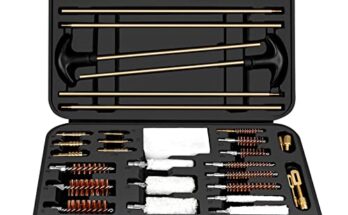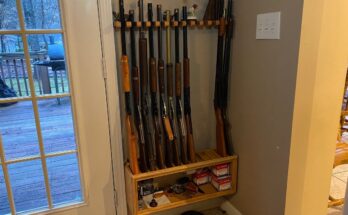An air rifle works by utilizing compressed air to propel a projectile with high velocity and accuracy. In simple terms, the compressed air is released when the trigger is pulled, which pushes a piston forward, compressing the air behind it.
As the piston rapidly moves back, it creates a sudden expansion of air that propels the pellet or bullet out of the rifle’s barrel. This air propulsion system makes air rifles an efficient and popular choice for various purposes such as target shooting, pest control, and small game hunting.
With advancements in technology, modern air rifles are designed to deliver improved accuracy and power while being quieter and more environmentally friendly than traditional firearms.
Components Of An Air Rifle
An air rifle is a complex piece of equipment that functions through the collaboration of various components. Each component has a specific role to play in the overall functionality of the rifle. In this section, we will explore some of the key components that make an air rifle work.
Barrel And Breech
The barrel and breech are essential parts of an air rifle that play a critical role in accuracy and power. The barrel is a long metal tube through which the pellet or BB travels. It provides guidance and stability to the projectile as it exits the rifle. The length and smoothness of the barrel can affect the velocity and accuracy of the shot.
The breech, on the other hand, is the section where the pellet or BB is loaded into the rifle. It is designed to seal the chamber and prevent any gas leakage during the firing process. The breech also houses the mechanism for loading and securing the pellet in place.
Trigger And Safety Mechanism
The trigger and safety mechanism are crucial components that ensure safe and controlled operation of the air rifle. The trigger is the part that is pressed by the shooter to initiate the firing process. It releases the sear, which allows the compressed air or gas to propel the projectile out of the barrel.
The safety mechanism is designed to prevent accidental discharge of the rifle. It acts as a safeguard, allowing the shooter to engage or disengage the trigger based on their readiness to fire. The safety mechanism typically includes a switch or lever that can be easily manipulated to ensure safe handling of the rifle.
Stock And Sight Systems
The stock and sight systems are components of the air rifle that contribute to its ergonomics and accuracy. The stock is the part of the rifle that the shooter holds and rests against the shoulder. It is designed to provide stability and support during aiming and firing. The stock can be made from various materials, such as wood, synthetic materials, or metal, depending on the type of air rifle.
The sight system refers to the components that aid in aiming and targeting. It typically consists of front and rear sights, which help the shooter align the rifle properly with their target. The sight system may also include features such as adjustable windage and elevation to compensate for different shooting conditions.
Types Of Air Rifles
When it comes to air rifles, there are several types available on the market. Understanding the different types of air rifles will help you choose the one that suits your needs and preferences. In this section, we will explore three common types of air rifles: Spring-Piston Air Rifles, CO2-Powered Air Rifles, and PCP (Pre-Charged Pneumatic) Air Rifles.
Spring-piston Air Rifles
A Spring-Piston air rifle is one of the most popular types of air rifles. It operates using a coiled spring and a piston mechanism. When you cock the rifle by pulling the barrel down, the coiled spring gets compressed. As you pull the trigger, the compressed spring pushes the piston forward, which in turn compresses the air in the cylinder. This compressed air propels the pellet out of the barrel with high speed.
Co2-powered Air Rifles
CO2-Powered air rifles use compressed carbon dioxide gas as the propellant. These rifles typically have a small CO2 cartridge that fits into a designated compartment. When you fire the rifle, the trigger releases a controlled amount of CO2 gas into the chamber, which then propels the pellet out of the barrel. CO2-Powered air rifles are known for their ease of use and convenience, as they don’t require manual cocking or pumping.
Pcp (pre-charged Pneumatic) Air Rifles
PCP (Pre-Charged Pneumatic) air rifles are considered high-end air rifles. They operate using compressed air stored in a tank or reservoir. Before using a PCP air rifle, the reservoir must be filled with compressed air from a scuba tank, a hand pump, or a high-pressure compressor. When the trigger is pulled, the compressed air is released, propelling the pellet with high velocity. PCP air rifles are known for their accuracy, power, and consistency.
In summary, the three types of air rifles discussed – Spring-Piston, CO2-Powered, and PCP – operate using different mechanisms to propel the pellets. Whether you prefer the simplicity of a Spring-Piston air rifle, the convenience of a CO2-Powered air rifle, or the power and accuracy of a PCP air rifle, there is a perfect option for every shooter. Choose the type that aligns with your shooting style and enjoy the thrilling experience of shooting with an air rifle.The Working Mechanism
An air rifle operates on a relatively simple working mechanism, which involves the compression and expansion of air, the firing sequence, and the propulsion of the pellet. Understanding the intricate details of how an air rifle works adds to the fascination and appreciation of this technology.
Compression And Expansion Of Air
When the trigger is pulled, a piston within the air rifle’s chamber moves backwards, creating a vacuum that draws air into the chamber. Subsequently, the piston compresses the air, raising its pressure and potential energy.
Firing Sequence And Pellet Propulsion
The firing sequence initiates as the trigger releases the compressed air, rapidly propelling the pellet through the barrel. The force generated from the rapidly expanding air accelerates the pellet to high velocities with remarkable precision.
Accuracy And Range Factors
Accuracy and range are crucial factors in understanding how an air rifle works. By maintaining precision and a good range, air rifles ensure accurate shots and effective targeting.
Sight Alignment And Windage
Pellet Shape And Weight Impact
Understanding Air Density Effects
Accuracy and Range in an air rifle are influenced by various factors that affect the trajectory and the ability to hit targets consistently.
Sight Alignment And Windage
- Sight Alignment: Crucial for accuracy, ensuring the front and rear sights are properly aligned is essential.
- Windage Adjustment: Correct for crosswinds by tweaking the windage, ensuring pellets hit the intended target.
| Factor | Importance | Impact |
|---|---|---|
| Pellet Shape | Medium | Greatly affects flight path and accuracy. |
| Pellet Weight | High | Heavier pellets tend to be more stable and accurate. |
Understanding Air Density Effects
- Air Density Impact: Impacts pellet velocity and trajectory.
- High Density: Increases air resistance, reducing range and accuracy.
- Low Density: Allows pellets to travel farther with reduced drag.
Maintenance And Care
An air rifle operates by utilizing compressed air to propel the pellet. Proper maintenance and care, including regular cleaning and lubrication, are essential for optimal functioning and longevity of the air rifle. Regular inspections and adjustments are also necessary to ensure accuracy and safety.
Maintenance and care are crucial aspects to ensure the longevity and optimal performance of an air rifle. Properly maintaining your air rifle involves regular cleaning and lubrication to prevent wear and tear.Cleaning The Barrel And Bore
Regularly clean the barrel and bore using a cleaning rod and patches to remove debris. Avoid using abrasive materials that can damage the rifling. Clean in a gentle, circular motion to avoid scratching the barrel.Proper Lubrication And Seal Checks
Apply a small amount of air gun oil to keep the moving parts lubricated. Check the seals for any signs of wear or damage to prevent leaks. Regularly inspect and replace any worn seals. Remember, proper maintenance of your air rifle is essential to ensure its longevity and accuracy. By following these simple care tips, you can enjoy consistent performance from your air rifle.Safety Considerations
Safety considerations are paramount when it comes to using an air rifle. It is essential to handle and store an air rifle properly and follow basic firearm safety rules to ensure the well-being of yourself and others. Let’s discuss the safety precautions under the following headings:
Handling And Storage Precautions
When handling an air rifle, it’s crucial to treat it as you would a conventional firearm, with the same level of respect and care. Always keep the rifle pointed in a safe direction and never point it at anything you don’t intend to shoot, whether the gun is loaded or not. Store the air rifle and its ammunition separately in a secure location, out of the reach of unauthorized individuals, such as children or visitors. Providing locks for both the rifle and ammunition can offer an additional layer of security.
Basic Firearm Safety Rules Apply
When using an air rifle, basic firearm safety rules should be followed at all times. Always keep your finger off the trigger and outside the trigger guard until you are ready to shoot. Be sure of your target and what is beyond it before taking a shot. Additionally, familiarize yourself with the specific safety features and mechanisms of your air rifle, and regularly inspect and maintain the rifle to ensure its proper functioning.
Frequently Asked Questions On How Does An Air Rifle Work 2
How Does An Air Rifle Work?
An air rifle works by using compressed air to propel a pellet or BB out of the barrel. When the trigger is pulled, the compressed air is released, pushing the projectile down the barrel at high speed. Air rifles are popular for target shooting and pest control.
What Are The Main Components Of An Air Rifle?
The main components of an air rifle include the barrel, stock, trigger, action, and optics (if applicable). The barrel is where the projectile is propelled, the stock provides stability, the trigger controls firing, the action houses the mechanism, and optics enhance accuracy.
Are Air Rifles Safe To Use?
Yes, when used responsibly and in accordance with safety guidelines, air rifles are safe to use. It’s important to always treat an air rifle as if it were a real firearm, follow proper handling procedures, and wear appropriate eye protection.
Training and supervision are essential, especially for beginners.
Conclusion
Understanding how an air rifle works is essential for any enthusiast. They operate by compressing air to propel pellets with precision and power. By learning about the mechanism and components, you can fully appreciate the skill and technique required for accurate shooting.
Through regular practice and maintenance, you can optimize your air rifle’s performance for an enjoyable shooting experience.


